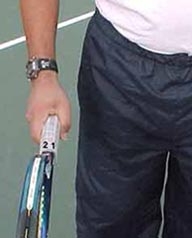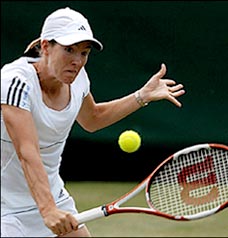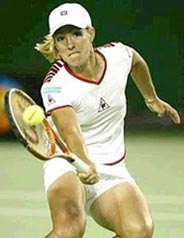|
TennisOne Lessons Implementing a Proven Training Program David W. Smith, Senior Editor TennisOne In my Last article (Creating a Proven Training Program), I outlined the concept of creating a six month training program that will create a proven pathway for players to reach not just highly skilled levels of tennis, but one that will allow players to reach their full potential. Let me be a little blunt here: If you are one who won’t try new things, who balks at anything that initially feels uncomfortable or gives up easily, this program is probably not for you.
I’ll be even a little more blunt: If you are a player who has been stuck at the 3.0 or 3.5 level for more than a year, even though you practice regularly, you most likely will stay at that current level for life. That may sound a bit dismissive on my part, since obviously I don’t know you or know how you play. However, I’ve worked with over 3500 players and without exceptions, I have seen the same limitations that prohibited players of all ages, abilities, and sex, from reaching their potential. I outlined many of the reasons players stagnate at levels usually far below their potential in my previous article. Understand that “potential” is defined by four main issues:
Let me first point out what may not be obvious: The LEAST important of these four components that define true player potential is “Athleticism.” Among the 3500 players I’ve taught, in honesty, only a handful, perhaps five or so, truly lacked the necessary athleticism required to reach relatively high levels of skilled play. Ironically, the most important concept, in my opinion, is education. Players may possess plenty of determination, discipline, drive, dedication, and even sacrifice, yet within these concepts that define overall desire, I can't tell you how often I've walked on a court and noticed a player diligently practicing a serve or volley — the problem is, they were practicing and reinforcing poor technique.if a player works consistently on poor techniques and tactics, they generally get very good at being bad. While that may sound a little ‘tongue in cheek’, the reality is that when players are taught—or are self taught—methods that are inferior, they seldom reach their potential. It is a little like the pianist who only used two index fingers to play the piano for twenty years: they may become very good at playing simple songs, however, more complex and difficult songs will be well beyond their reach — and so will Carnegie Hall.
Foundation Development If you are still reading this article, then that is a good sign you are truly engaged in wanting to move past your current level of playing ability—or you are a beginner who does not want to waste time learning methods that at some point MUST change for you to reach your tennis playing potential. Good! You are now on a path to either reconstructing your game or creating an “advanced foundation” as you learn the game for the first time. Advanced Foundation The idea of developing grips, strokes, and footwork patterns that lead to continuous improvement has to do with what I call, The Advanced Foundation, and it applies to each and every stoke on the court. And, nearly all high-performance techniques are not difficult to learn and master when given the correct tools for such mastery. This is where many pros and coaches fail their students. There is a common belief that more advanced grips and strokes are “too difficult” to teach and for beginners to master. In fact, there are two reasons for this philosophy: Either the pro or coach simply doesn’t know how to teach an Advanced Foundation effectively, or that there is a sincere belief that beginners can’t do certain things and will become frustrated. Ironically, the most frustrated students I’ve even seen are those who learn inferior—but arguably ‘easier—methods as beginners. These players, even years or decades later, find it very difficult to change those methods when they have long discovered they are not improving. Advanced Foundation Components Here is a simple list of the Advanced Foundation Grips and Strokes that you will want to master. In the next few articles on this topic, I’ll be providing you more and more ways that will make acquisition and mastery of these foundation components easier to accomplish.
Why the Continental Grip
Ironically, of the 117 books I personally own on tennis, nearly ALL of these books promote the “eastern forehand and backhand grips” for the beginning volley player. However, nearly ALL of these books go on to say, “As the player improves, they will need to advance to the continental grip at some point.” I ask you this simple question: Why would you want to spend one moment of time developing and mastering an inferior method that MUST change later to become more skilled? The reality is, once a player begins to compete with inferior methods, the chance of making any change in the grip becomes exponentially more difficult. Because we want to win when we play tennis, we seldom will adopt grips that feel uncomfortable in competition. We almost always revert back to the comfort levels of our game…unless we know that we must make the change. (Even then, many players, even those who clearly understand the need to make a change in their stroke or grip, will invariably revert back. Those who are given the tools to master the new method can overcome this propensity. That is what I will be doing for you in this series of articles. Importance of the Continental Grip Of all the grips, the continental is usually the least comfortable grip for players to use. It feels weak, it feels foreign, it feels uncomfortable. The drills I present here not only will help you gain comfort and control using this grip, the drills will help you master all the shots that use this grip, including:
Obviously, from this list of shots that advanced players use the continental grip on, it would seem to be a very important grip! And it is! And, conversely, it is the main reason so many players fail to move past lower levels of stroke production! Drills Practicing the Continental Grip:
Obviously, there are dozens of actual volley drills to emphasize the use of the continental grips. Here, I wanted to present ways you can practice drills at home. I recommend practicing all these drills for no more than five minutes each time you practice, Do sets several times a day. If you do about five sets a day, at vie minutes each set, you will begin to feel comfortable with the continental grip in about a week. Yes, one WEEK! Conclusion Next time, I'll be discussing stroke patterns, grips, and footwork patterns associated with developing an Advanced Foundation on groundstrokes.
Your comments are welcome. Let us know what you think about Dave Smith's article by emailing us here at TennisOne .
|
||||||||||




 Your comments are welcome. Let us know what you think about this article by
Your comments are welcome. Let us know what you think about this article by